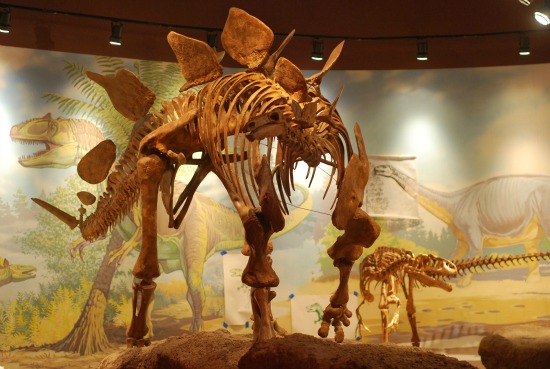Stegosaurus Plate Debate
Stegosaurus is immediately recognizable for its prominent plates, but why did these structures actually evolve?
![]()

Thanks to a row of huge bony plates, Stegosaurus remains one of the strangest dinosaurs ever found. Photo by the author at the Utah Field House of Natural History in Vernal, Utah.
Undoubtedly familiar to any dinosaur fan, Stegosaurus remains one of the strangest dinosaurs ever discovered. Even among others of its kind, the iconic Jurassic herbivore looks like an oddball. Many other stegosaur species sported long rows of spikes and short plates, but the flashy Stegosaurus had an alternating row of huge bony plates along its back and a relatively modest set of four tail spikes. How could such a strange arrangement of adornments have evolved?
From the arms of tyrannosaurs to the necks of sauropods and the armor of stegosaurs, bizarre dinosaur structures have frequently made paleontologists wonder “What was that for?” There had to be a reason for the deviations in form, and, paleontologists believe, the immediately recognizable plates on the back of Stegosaurus must have had some function. There has been no shortage of hypotheses. Off-the-wall ideas about flying stegosaurs aside, researchers have proposed that the plates along the spine of Stegosaurus protected the dinosaur from attack, were the Jurassic equivalent of solar panels or acted as sexy billboards to attract the attention of potential mates.
Although Stegosaurus certainly had much to fear from the contemporary Morrison Formation predators Allosaurus, Torvosaurus and Ceratosaurus, the dinosaur’s defensive weapons were its tail spikes (called a “thagomizer” by some). If Stegosaurus was anything like its spikier cousin Kentrosaurus, it could swing its tail with deadly force, and a damaged Allosaurus bone suggests that the “roof lizard” did just that. But the keratin-covered plates of Stegosaurus probably didn’t provide the herbivore with much additional protection. The immobile structures jutted upwards, leaving the dinosaur’s flanks exposed to attack. To call the plates “armor” isn’t quite right.
When I was a kid, though, Stegosaurus plates were more often said to help the dinosaur regulate its body temperature. Presuming that Stegosaurus was an ecothermic animal–that is, had a body temperature determined by the surrounding environment–the plates could have helped the dinosaur heat up by turning broadside in the morning and shed heat by turning toward the sun during midday. Using models of plates in wind tunnel experiments, paleontologist James Farlow and colleagues reported in 1976 that the plates could very well have been used to dissipate heat. This doesn’t mean that the plates evolved for that function, though.
In 2010, Farlow and coauthors followed up on the work by comparing the plates of Stegosaurus to the bony armor along the backs of modern crocodylians. While stegosaur plates might have played some passive role in regulating body temperature, they concluded, there was no indication that Stegosaurus plates evolved for that reason, or even were principally used as thermoregulatory equipment. (Not to mention the fact that we now know that dinosaurs were not lizard-like reptiles whose internal physiology was primarily dictated by the temperature outside.) If Stegosaurus plates made any difference in managing body temperature, it was a happy little quirk that rode along with the principal function of the plates.
At present, it appears that the impressive bony fins on the back of Stegosaurus evolved as display structures. A 2005 study by Russell Main and collaborators, which focused on the microstructure of stegosaur plates, couldn’t find any evidence that the structures were used to radiate heat. Indeed, if stegosaurs truly required such radiators, it’s surprising that Stegosaurus seems unique in its plate arrangement–if plates were really used to regulate body temperature, you’d expect to see the same arrangement in many closely related species. Instead, much like the horns of ceratopsid dinosaurs, the plates and spikes of stegosaurs varied greatly between species. This suggests that visual display was driving the evolution of these structures. Being recognized as a member of a particular species, or displaying an individual’s maturity and vigor during mating season, probably drove the divergence in form among stegosaur ornaments. The question is whether stegosaur plates made any difference in the mating season or they simply served to help species recognize members of their own kind. That debate–over the sexiness of plates, spikes, horns, crests, sails and domes–is just heating up.
References:
Farlow, J., Thompson, C., Rosner, D. 1976. Plates of the dinosaur Stegosaurus: Forced convection heat loss fins? Science. 192,4244: 1123-1125
Farlow, J., Hayashi, S., Tattersall, G. 2010. Internal vascularity of the dermal plates of Stegosaurus (Ornithischia, Thyreophora). Swiss Journal of Geosciences. 103, 2: 173-185
Hayashi, S., Carpenter, K., Watabe, M., McWhinney, L. 2011. Ontogenetic histology of Stegosaurus plates and spikes. Palaeontology. 55, 1: 145-161
Main, R., de Ricqlès, A., Horner, J., Padian, K. 2005. The evolution and function of thyreophoran dinosaur scutes: implications for plate function in stegosaurs. Paleobiology. 31, 2: 291-314
Padian, K., Horner, J. 2010. The evolution of “bizarre structures” in dinosaurs: biomechanics, sexual selection, social selection, or species recognition? Journal of Zoology. 283,1: 3-17
/https://tf-cmsv2-smithsonianmag-media.s3.amazonaws.com/accounts/headshot/RileyBlack.png)
/https://tf-cmsv2-smithsonianmag-media.s3.amazonaws.com/accounts/headshot/RileyBlack.png)